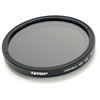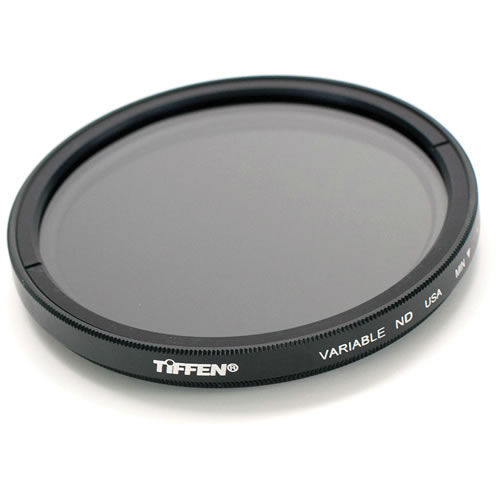- Webcode: 262737 • Mfr: 82VND
- FREE SHIPPING Available
Product Highlights
- ND Neutral Density Filter
- 2-8 Stop Reduced Exposure
- 82mm Diameter Thread
- Allows for Use of Wider Aperture

Tiffen 82mm Variable ND Filter
Tiffen 82mm Variable ND Filter- Available in Calgary
- Available in Edmonton
- Available in Mississauga
- Available in Ottawa
- Available in Toronto
- Toronto In Stock
- Ottawa In Stock
- Mississauga In Stock
- Calgary In Stock
- Edmonton In Stock
Rent this for: $12/day Learn More
Overview
The Tiffen Variable ND filter is a unique, versatile and flexible tool, affording you the convenience of using several Neutral Density filters all in one. Primarily used as a photographic tool for controlling depth of field and exposure, the Variable ND is being sought in the video market as well because it is fast, easy to use, small, lightweight, and does not require additional accessories such as a matte box.
- Provides 2 to 8 stops of light control
- Thin profile ring - 9mm
- Wider outer optic to help reduce vignetting at wide angles
- Comes in Tiffen Professional packaging with padded black nylon pouch
- Made with high quality optical glass using Tiffen's ColorCore™ technology
- Made in the USA
Tiffen Variable Neutral Density Basic User Guide
Why use a Variable ND Filter?
Neutral density filters reduce the amount of light going through the lens into your camera. By reducing the light you are able to achieve the following:
- Allows the use of slow shutter speeds, with high speed films or digital cameras, to record movement/image blur in subjects such as waterfalls, clouds or any fast moving subject
- Gives you full control over your depth of field. You are able to decrease depth of field by using wider apertures, which helps separate subjects from their background (subject matter in focus while your background is blurred)
- Allows you to shoot high speed film (above ISO 400) in bright outdoor situations by reducing effective ISO
- Enables cine and video cameras (which have fixed shutter speeds) to film subjects such as snow, sand or other bright scenes which could cause overexposure
The Tiffen Variable ND filter operates on the same principle as a Circular Polarizer – rotate until you reach your desired effect and shoot. It allows you to have continuous control over the amount of light coming through your lens in an approximate range of 2 (ND 0.6) to 8 (ND 2.4) stops – while maintaining the integrity of your image. Note: The evenly spaced indexing marks between MIN and MAX do not represent calibrated stops. They are for reference only, to be used as a density bench-mark to return to a previous setting.
How to Care for Your Variable ND
Your Tiffen Variable ND should be handled with care to avoid dirt, scratches and fingerprints. Store it in its protective pouch when not in use. Your filter can be damaged by being dropped, by overexposure to extreme temperatures or humidity, improper cleaning, or by being left unprotected in direct sunlight. Use cleaners that are made specifically for cleaning filters and optical lenses and follow product instructions.
All Tiffen filters are made in the USA using proprietary ColorCore™ technology
IMPORTANT
Only use your Variable ND within its recommended 2 to 8 stop range. If you go beyond the “MAX”, you may experience an uneven exposure or color shift that appears as an “X bar” in the image. This is more common when using higher densities on full frame cameras; however, can be experienced on any camera. This is a common issue– it’s the law of physics when combining two polarizing filters; however, this issue can be eliminated. First, adjust your focal length and then reduce the density (stop value) setting by rotating the filter ring until the color shift disappears.
The Tiffen Variable ND has a thin profile with a wider outer ring to help eliminate vignetting when using wide lenses. However, due to the vast number of combinations of cameras, lenses, sensors and other factors, we can NOT predict under what circumstances vignetting will occur and to what degree. We suggest simply adjusting your focal length, position and/or composition to remove the vignetting—use your digital camera’s display for reference.
NOTE: The small indexed dots on the filter ring between “MIN” and “MAX” density settings are intended for reference only. They are not representative of a specific density (stops).
How do I use my new Variable ND Filter?
Mount your Tiffen Variable ND to the front of your lens and set to the “MIN” (lightest) density. Frame and focus as usual on the minimum density setting. Sometimes your lens may not focus properly on a heavier (darker) density. If this occurs, focus at the “MIN” density setting, then turn off Auto Focus (set on Full Manual Mode) and turn the ring to the desired density. The heavier the density, the slower your shutter speed will be. This longer exposure allows the shutter to remain open long enough to record the same amount of light.
For example, when shooting outdoors your camera’s shutter speed may be set at 1/500 at f8 with no Variable ND on the lens. By adding a Variable ND filter to your lens and setting it at the minimum density (2 stops) the shutter speed is now 1/125 at f8 and at maximum density (8 stops) your camera’s shutter speed would be ½ second at f8. This could be converted into even slower equivalent exposure by reducing the lens aperture - 1 second at f11, or 2 seconds at f16, or 4 seconds at f22.
- With the Tiffen Variable ND filter mounted to your camera lens, reset the ISO to the lowest setting especially if you are trying to achieve image blur. This will give you longer exposure times and minimize noise
- Rotate the ring to the MIN density setting. Focus your image. Once you have grabbed focus, turn OFF your Auto Focus and set to Full Manual Mode
- Your camera’s internal exposure meter will not be completely accurate when determining the exact exposure when using a Variable ND at high density values; however, the reading it gives you will be relatively close. When using a DSLR in the manual mode, the histogram will give you more control of your exposure as you go through your test shots. Use this as a starting point and look at this as an opportunity to really learn more about the relationship between f-stops and exposure time
- Now you have your image in focus, you’ve turned off the Auto Focus and set your camera on Manual Mode, and based upon your internal exposure meter you have turned the ring to a setting that you think will give you the result you’re looking for — for example, f8 with an exposure time of 1/15 seconds — take a test shot
- If the image appears overexposed, then reduce your exposure time or reduce your aperture, depending on whether or not you want to affect your depth of field (changing your aperture changes your depth of field). By the same token, if the image is underexposed, open up the aperture or increase the exposure time. With some practice, you should be able to go from that initial test shot to an actual usable image within two or three attempts
- When using a film camera, bracket first and record your exposures. The indexing on the outer ring will prove useful; however keep in mind these marks are not calibrated to specific densities
What's Included
- 82mm Variable ND Filter
Reviews
Questions & Answers
Tiffen 82mm Variable ND Filter
Looking for a personal touch? Not sure if you are choosing the right product? Our staff is here to help.
We want to make sure you get the right product for your needs.
Our staff will help you understand the options available so you can be confident in your purchase.
As the country’s leading Professional Imaging retailer, Vistek is in the perfect position to ensure you make the right choice.
Contact us today for a personal touch.


